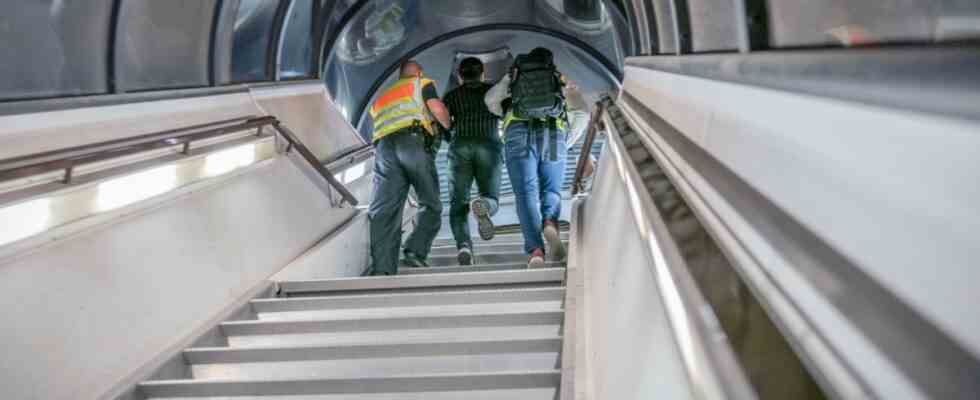The Swedish government launched a campaign this week to fix its country’s image in the rest of the world. Refugees please stay outside, there is no longer a welcoming culture in Sweden – that’s roughly the message. Minister Maria Malmer Stenergard, who belongs to the “Moderate Coalition Party”, which is considered to be moderate right, stands for the turning point in Swedish politics, which she recently described with the controversial sentence: There is a “shadow society” shaped by migrants, and we must now “eradicate”. According to Swedish commentators, Stenergard apparently wants to overtake the right-wing populist “Sweden Democrats”, on whose support the government depends, on the right.
This Thursday, Maria Malmer Stenergard will host the 26 other ministers responsible for migration issues in the European Union. Is the Swedish government, which currently holds the EU presidency, putting its “Swedish Democrat” stamp on European migration policy? Stenergard denies that. Sweden puts itself at the service of the common European cause, she says. But the topic that will be discussed at the council meeting in Stockholm fits with their concept of migration policy. It’s about deportations.
The EU’s previous strategy has not worked
Stenergard’s compatriot Ylva Johansson, the EU commissioner responsible for migration, presented a strategic plan on Wednesday that describes how EU states can send more migrants without a right to stay back to their countries of origin. Johansson did so with some contrition. It was only in April 2021 that her authority presented a strategy that focused primarily on voluntary returnees. In addition, they wanted to use the lever of visa and trade policy to put pressure on countries that refuse to take in those seeking protection who have been rejected in Europe. Apparently that didn’t work.
According to the EU Commission, 29 percent of those people who should have left the EU states left the country in 2019. In 2021 the rate was only 21 percent. The Brussels authority had announced a target of around 70 percent in 2018. Johansson refused to formulate a new goal on Wednesday. That is up to the member states, she said. In any case, their strategic plan is intended more as an appeal to the 27 to finally pull together: the governments should join forces, speed up processes, advance the digital registration of migrants, hire more professional return advisors – and, above all, the help of the border protection agency Frontex in the case of deportations take advantage of.
European migration policy has been one big construction site for years, and the EU institutions are now scrambling to shut it down by the end of next year’s legislature. Various legislative projects are in progress in the Council and Parliament, the main focus being on the registration and control of asylum seekers at the external borders.
To speed things up, a special summit of heads of state and government has been convened for February 8th and 9th in Brussels. What will be discussed: protecting external borders, putting a stop to smugglers, strengthening cooperation with countries of origin and transit, accelerating deportations. It’s the usual topics.
In 2022 there were 300,000 illegal entries, 100,000 more than the year before
Commissioner Johansson has been fighting for a uniform European migration policy, the so-called Migration Pact, since she took office in 2019. There is not much time left and the need is increasing again, as she explained on Wednesday. The asylum system in Europe is currently under “immense pressure,” she says.
In 2022, the commission counted more than 300,000 illegal entries, 100,000 more than the year before. She put the number of applications for asylum at 924,000. The discrepancy between entries and applications is partly due to the fact that many people came to the EU legally and then asked for asylum. But there are also many refugees who have applied in several countries. “An abuse of the system,” reproaches Johansson. It is increasingly causing discord in the EU and could also overshadow the February summit.
The Dutch government has now asked the Commission to take action against so-called secondary migration and to publish statistics on which countries are not complying with the Dublin rules. Greece and Italy should feel particularly addressed. In principle, the Member State to which the asylum seeker first entered is responsible for the asylum procedure. If the refugee travels further and applies again in another country, they can be sent back to the country of first reception. But even this form of internal EU deportation only works very rarely. This explains the high number of asylum seekers in countries such as Germany, the Netherlands, Belgium and above all Austria. The government there is now openly promoting the construction of fences at the EU’s external borders and the softening of European asylum law.
European migration policy has been going in circles for years, and the merry-go-round will only come to a standstill if the 27 states find a stable balance: on the one hand in responsibility for protecting and controlling the external borders and on the other hand in the solidarity distribution of refugees among the 27 states. The Swedish Presidency, with Minister Maria Malmer Stenergard, should not be expected to lead the way on solidarity issues. Their motto is: deportation and deterrence. And it’s being shared in more and more countries.

